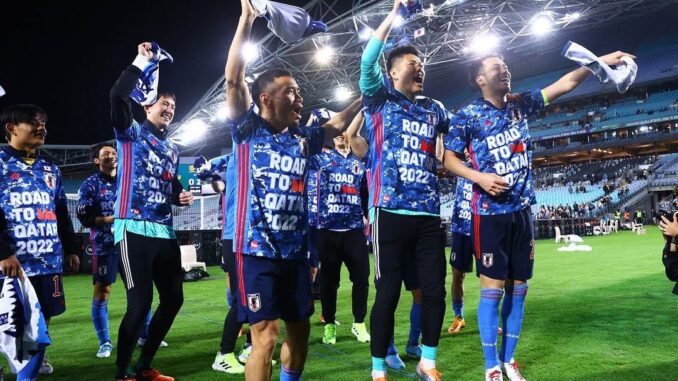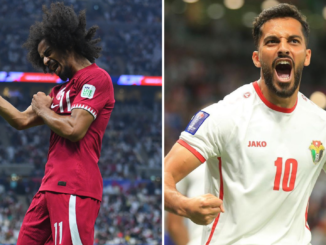
Four years is a long time in football.
Drawing to a close another cycle of qualification in Asia, Iran, South Korea, Saudi Arabia and Japan will once again represent the continent in the main World Cup draw this coming Friday, with Australia having again to go through the playoffs, this time alongside UAE.
But as we reach a natural time to review Asian international football, have we seen any improvement across the continent? And what can we expect from our performances in Qatar in less than nine months’ time?
For outsiders looking in, it’s a case of same old, same old; the same four nations qualify for the second World Cup in succession, with an outside chance of making that the same five nations once the intercontinental playoffs are concluded in June.
Inside Asia, there is little surprise. Many will have tipped the exact four teams to qualify, and the exact two teams to contest the playoffs way back when the initial qualification draw took place in late 2018.
Predictability is generally a sign of weakness, a broad assessment that indicates stagnation and a clear hierarchy at play.
But while this conclusion was expected, results over the last week, including draws between Saudi Arabia (who at the time were top) and China (who finished second to bottom) and Japan (who at the time were top) and Vietnam (who finished bottom) in Group B, provide a small indication that the hierarchy isn’t as distinct as may be the case in other regions, such as Europe.
While the gap in-between the top 10-15 nations may not be demonstrably increasing, it’s unquestionable that this qualification phase in its entirety has been pretty dire on the entertainment stakes.
While COVID had a part to play in this; the Second Round for one would’ve played out much differently, given Iran and Saudi Arabia’s progression hopes were hanging in the balance before the pandemic took full effect. While the Third Round was played in early parts behind closed doors, the eventual run in, when normality resumed, was equally laboured.
In the last week, we’ve seen intense scrutiny on managers of six out of the seven remaining AFC nations in the race for qualification; only Saudi Arabia, under the tutelage of Herve Renard feel like a stable ship in Asia, with unified fanbase backing. Given their past, that observation feels even more impressive.
Whether this is a sign of the times; Asia, like the rest of modern football is generally less patient than it was a decade ago, or whether we’re living through a time where Asian football is at its weakest, only events at the World Cup later this year can truly attest to that.
It was the first World Cup cycle for a long time however where no real stand out players emerged from it.
In general, the continental stars – the likes of Son Heung-min, Sardar Azmoun, Salem Al-Dawsari – all performed well and inspired their nations over the line, but it’s difficult to really put together a set of players, or “best XI” that represents individual performances that really outperformed their expectations on a consistent basis.
It’s untrue that we haven’t seen notable performances in isolation.
Japan, probably one of the few sides to succeed under transition, enabled Ao Tanaka and Junya Ito (one of the joint top goalscorers on four from ten matches) to raise their profile to another level, but in general the top teams managed games out, rather than really having to up their game.
Criticism is rightly being pointed at the chasing pack, who again disappointed in bridging the gap on a consistent basis.
Much of the hype going into this cycle surrounded the individual talents of Ngyuen Quang Hai at Vietnam, the newly nationalised talents of China and UAE and Syria’s talisman Omar Al-Somah. All flattered to deceive as their nation’s progress broadly stagnated over the last four years.
Oman will exit as being the only real side with little to complain about. Finishing a single point behind Australia in the third playoff position, such a record is far beyond what many would have tipped the Gulf side to achieve.
While we saw glimmers from the upcoming Arshad Al-Alawi and Zahir Al-Aghbari, it’s difficult not to be cynical, that without Croatian coach Branko Ivankovic on the sidelines this qualification stage would have been a wholly different story.
In many ways, the coaches have been the stars (or villains) of the last four years.
Considering those on the fringes, UAE changed their coach five times over qualification, Iraq four times. For every Ivankovic, there was a Li Xiaopeng of China, or Nizar Mahrous who couldn’t inspire the same level from Syria as was the case in the run up to the 2018 World Cup.
Vietnam have long been defined by their coach, Park Hang-seo, over any individual performer; ultimately his philosophy offered steely organisation but very little flair offensively.
Of those that have progressed, the aforementioned Renard stands tall at the summit, guiding his side to top spot over Asian heavyweights Japan and Australia, while Hajime Moriyasu at Japan and Paulo Bento at Korea have much to prove that their successes over this period hasn’t been rooted in having a purely better quality of players at their disposal, ahead of their tactical know how.
For Iran, it seems an age since the Marc Wilmots debacle that threatened to derail their qualification hopes back in the Second Round; but memories are fleeting, as Dragon Skocic is starting to feel in the last week.
In truth, Team Melli’s transformation from an archetypal reactive underdog, more than the sum of their parts, led by Carlos Queiroz, into a modern, internationally competitive, attacking side will only be realised in Qatar; something at the moment many fans will have question marks over.
We’re left then in a quandary to whereabouts Asian football sits.
While individual player quality is on the rise; as can be demonstrated by the rising profiles of Iranian, Japanese and Korean players in Europe, Saudi Arabia’s growing technical ability of their young generation and hosts Qatar having proved they can be competitive at regional (Arab Cup) and international (Gold Cup and Euro qualifiers) level, few Asian fans will be so enamoured by their national team efforts as a collective.
As Europe mourns the likes of Italy and Sweden missing out on World Cup qualification, which also saw African giants Egypt and Nigeria, South America’s Chile and Colombia exit, it’s difficult to make a case that Asia, even considering UAE and Australia who at best crawled to their playoff finishes, deserve to increase their number of participants at a World Cup.
But increase it shall, with the World Cup in 2026 set to expand to 48 teams, with Asia’s slice of the pie to grow to eight teams.
With it comes a change in qualification format, that in its current guise many have criticised for years, something that’ll undoubtedly be held responsible for any drop off in performance in Qatar.
I’ve long commended the current World Cup structure (aside from the ill-thought through Round 1 exclusion of developing Asian nations), as it simultaneously grants the lower end of Asian football competitive football across the full breadth of the continent within the Second Round, before splitting the confederation to ensure more balanced, competitive football to end qualification within the Third Round – for both World Cup, and as we’ll see in June, for the Asian Cup.
For the 2026 cycle, with eight qualifying spots on offer, the structure does require an overhaul; even if one of the proposed routes would be to keep with the current format, and qualify the top 4 (from 6) in each final group stage.
The other speculated proposal, which was leaked last week is to shorten group phases at both the Second and Third Rounds, and bring in more jeopardy by increasing the number of winner takes all playoffs.
From a spectacle standpoint, this makes sense. Tuesday night’s blockbuster ties in the African World Cup qualification phase forced even the best in the continent to play a two-legged tie to qualify for Qatar.
A move to such a format would indeed remove the security of a year-long league-style phase that the likes of Japan and Korea have benefitted from for decades, but does it really improve the quality of the continent overall?
The expanded Asian Cup in 2019 illustrated the progress the current version of World Cup qualification has done for the depth of quality in the continent. This was mirrored in Asia’s performance in Russia’s 2018 World Cup.
The simultaneous growth in participation of Asian players in Europe, alongside improvements in Asian club football – through the Saudi Pro League and J.League in particular – means there is a case to be said that the overall quality of Asian football has risen over the last four years.
In many ways, the constraints in having to wait four years to assess Asia’s true place in world football, is the exact same criticism the elite nations call out, when requesting for increased in-cycle competition outside the continent.
A lack of available friendly slots, extinguished by the pandemic, and the growing penchant for Nations League style competitions (despite my objection to such a move for Asia), opportunities to properly gauge global standings have been brief.
As we anticipate the World Cup draw, an uncomfortable watch for any fan who continues to have question marks against their nation’s current progress, as we have seen across the last four years, coaches will have the biggest say in what we can expect in Qatar.
With a number of nations currently pondering taking the risk of switching managers at this late stage, their decisions will likely determine how Asia moves forward for the coming cycle.
Photo: IG/japanfootballassociation




